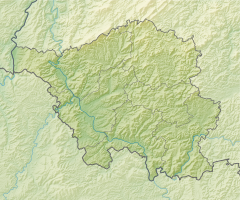Maybach mine
| Maybach mine | |||
|---|---|---|---|
| General information about the mine | |||
| Mining technology | Underground mining | ||
| Information about the mining company | |||
| Employees | 6,700 (1951), at the end of funding in 1964 approx. 4,300 | ||
| Start of operation | 1873 | ||
| End of operation | Production until 1964, finally shut down in 1981 | ||
| Successor use | industrial Estate | ||
| Funded raw materials | |||
| Degradation of | Hard coal | ||
| Geographical location | |||
| Coordinates | 49 ° 19 '15 " N , 7 ° 4' 5" E | ||
|
|||
| Location | Maybach | ||
| local community | Friedrichsthal (Saar) | ||
| Regional Association ( NUTS3 ) | Saarbrücken | ||
| country | State of Saarland | ||
| Country | Germany | ||
| District | Saar | ||
The Maybach mine is a former hard coal mine in the Maybach district in Friedrichsthal in the Saarland .
history
In the years 1873 and 1874 the new Trenkelbach mine was built in the west of Friedrichsthal: During this time the shafts I (later shaft Marie) and II (later shaft Albert) were sunk . Shaft III (Shaft Frieda) followed in 1901 after preliminary work had been underway since 1897. The east shaft (Margaretenschacht) was sunk from 1890. In 1882 the mine was named after the then Prussian Minister for Public Works Albert von Maybach . From 1884 workers 'and officials' houses were built, around 1900 the school and the four large sleeping quarters , this is how today's Maybach district came into being.
With the takeover of the two disused mines Helene in Friedrichsthal (1930) and Altenwald (1935), the Maybach mine with 18 shafts was one of the most important mining sites in the Saar district in the 1930s. The coking plant of the Altenwald mine was preserved after the merger and supplied by cable car from Maybach. After the Second World War , the Sulzbacher Mellin mine was also connected. In 1951, 6,700 people worked in the mine and 6,300 t / day were extracted.
In 1959 and 1960 the conveyor system of the Frieda shaft was rebuilt as a modern concrete headframe . At the beginning of the 1960s, around 4,300 miners were still working and extracting 3,000 tons of hard coal. In 1964 the mine was closed and it was used for material transport and for ropes until 1981 . The mining field was assigned to the Reden mine.
Accidents
On October 25, 1930 there was a serious mine accident . 98 miners were killed in a firedamp explosion .
Current usage
From the former pit, the hoisting machine houses and hoisting machines of the first three shafts, which are under monument protection, have been preserved. The former coffee kitchen with convenience store from 1897 is now used again as a restaurant. Some buildings have also been preserved from the former east shaft. The site of the pit was converted into an industrial area, here are medium-sized companies, but also a Lidl logistics center .
literature
- Delf Slotta: The Saarland coal mining industry. Verlag Krüger Druck und Verlag GmbH & Co. KG (Dillingen / Saar 2011), publisher: RAG Aktiengesellschaft (Herne) and Institut für Landeskunde im Saarland e. V. (Schiffweiler), ISBN 978-3-00-035206-5 .
Web links
Individual evidence
- ↑ The city of Friedrichsthal and its mines
- ↑ a b Saarland University: Places of cross-border memory, The Friedrichsthal and Maybach pits.
- ↑ Bergwerkssiedlung und Grube Maybach, ( Memento of the original from April 7, 2014 in the Internet Archive ) Info: The archive link was inserted automatically and not yet checked. Please check the original and archive link according to the instructions and then remove this notice. Saarland Tourism.
- ↑ a b Christian Jung and Werner Klär (eds.): Friedrichsthal - a journey through time . City of Friedrichsthal, p. 29.
- ↑ Brief history of the Maybach mine
- ↑ Mine accidents in Germany


